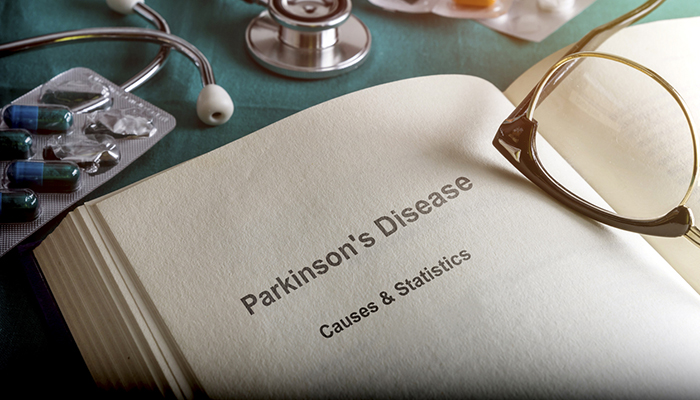Parkinson’s, a type of movement disorder, is a progressive neurological disorder with an unknown cause that affects dopamine producing neurons in the substantia nigra of the brain. Dopamine, a neurotransmitter, is a chemical responsible for transmitting information between neurons. This chemical helps in coordinating movement, learning, attention and emotional responses to a stimuli. Inability to produce sufficient dopamine results in the many symptoms associated with Parkinson’s.
The progression of the disease varies from individual to individual; however, the symptoms may be movement related (motor) or unrelated to movement (non-motor) in presentation. Motor symptoms may include tremors (noted during rest, most common being “pill rolling” movement in hands), rigidity (stiffness in limbs, trunk or neck), bradykinesia (progressive loss or slowing of movement), postural instability (resulting in loss of balance during walking or standing activities). Non-motor symptoms may involve depression, sleep and behavior disorders, cognitive impairments such as longer time to comprehend information and respond, constipation, impaired sense of smell, apathy and lack of facial expressions.
Unfortunately, by the time patients start experiencing symptoms and are diagnosed with Parkinson’s, most of the dopamine producing neurons have already been lost. Instead, an accumulation of abnormal neurons called Lewy bodies are found in the brain.
What is the impact of Parkinson’s?
The Parkinson’s Foundation estimates that 60,000 Americans are diagnosed with Parkinson’s disease annually, and the number of people living with Parkinson’s could grow up to one million by 2020. Roughly 4 percent of all Parkinson’s cases are diagnosed before the age of 50. Men are 1.5 times more likely to be affected by Parkinson’s than women; however, incidence increases with age. Centers for Disease Control and Prevention ranks complication arising from Parkinson’s as the 14th cause of death in the United States.
Managing Parkinson’s
Despite the prevalence and the debility resulting from Parkinson’s, there is no ultimate cure. Medical and therapeutic management aims to treat symptoms and slow the progression of the disease. Medical management includes Levodopa-Carbidopa (Sinemet, Requip) and Amantidine (to reduce involuntary movements). Surgical treatment involves deep brain stimulation to control motor symptoms but can lead to cognitive, behavioral and speech changes. Therapeutic approaches include performing strengthening, balance and coordination activities to improve motor performance and speech therapy to improve cognitive impairments.
At Encompass Health rehabilitation hospitals, rehabilitation doctors, in many cases a physiatrist, specialize in treating patients with various musculoskeletal, neurological and post-operative conditions that leave them unable to perform daily tasks such as getting dressed, walking to the restroom and getting out of bed.
Rehabilitation services could help them return home with increased independence. The physiatrist evaluates a patient’s medical needs and treatment goals. The patient is then referred to physical therapy, occupational therapy and speech therapy for a thorough assessment of strength, balance, coordination, motor and sensory deficits, swallowing difficulties and cognitive deficits as well as needs and concerns of family members and their caregivers.
The physiatrist and the rehabilitation team then create a customized care plan to help the patient and their caregivers achieve the best outcome.
Unlike an acute care hospital, where most treatment sessions are delivered at beside, Encompass Health encourages not only the patients but also caregivers to actively participate in daily treatment sessions, which are three hours a day, including physical and occupational therapy and speech therapy with the end goal of returning to previous level of function and home.
In addition, the rehabilitation team includes, nurses, case managers, pharmacists, psychologists, care transition coordinators and nutritionists. The length of stay at Encompass Health hospitals varies depending on a patient’s condition and needs, as well as functional improvements made during their stay.
Parkinson's Rehabilitation
Learn more about how inpatient rehabilitation can help you manage your Parkinson's symptoms.
Learn MoreHow Does Rehabilitation Help Parkinson’s?
People with Parkinson’s demonstrate freezing moments, difficulty with initiating and ceasing a movement, hyperkinesia (reduced amplitude/intensity of movement) resulting in shuffling gait pattern (short discontinuous steps, heel drag/tip toe walking, poor or impaired arm swing, trunk rotation), hypophonia (loss of loudness of speech), micrographia (progressive loss of font size while writing), uncoordinated movements, forward stooped posture and loss of balance (usually backwards) resulting in frequent falls.
Physical therapy for Parkinson’s patients focuses on improving movement coordination; quality of walking to a more rhythmic and coordinated pattern; postural stability for more upright posture; ability to get in and out of bed/chair with minimal or no help; and range of motion in limbs, trunk and neck in order to reduce the burden of care on caregivers.
Body weight supported treadmill training, equipment such as Lite-Gait over a treadmill or an AutoAmbulator with visual and auditory feedback, such as metronome beats and foot placement displayed on a screen, help in improving quality of gait with respect to stride length, step continuity, speed and reducing heel drag.
Biodex balance platform, inclusive of auditory and visual feedback, and choice of a stable or unstable base of support, provides an array of balance activities to train postural stability and balance recovery required to regain lost mobility and alleviate risk of falling in Parkinson’s patients. Dynavision, a type of light board, encourages a patient to reduce undershooting or overshooting a target (a result of incoordination, rigidity and bradykinesia) while promoting faster reaction time. Training on Dynavision could be performed while sitting or standing on a stable or unstable surface and can be made complex by facilitating dual tasking or multi-tasking.
Parkinson’s specific training exercises called Lee Silverman Voice Treatment (LSVT) Big are used by physical and occupational therapists to treat motor symptoms, and LSVT Loud is used by speech therapists to treat voice quality deficit for patients with Parkinson’s.
Driveable, a computer software designed to assess safe driving ability, is offered to patients who wish to return to driving. The results are shared with the patient and the psychiatrist; however, one must refrain from driving until approved by a physician. Besides family training sessions, the rehabilitation team at Encompass Health hospitals also promotes community reintegration training during inpatient stays to encourage community re-entry post discharge from the inpatient rehabilitation hospital.
Also offered are home assessments for patients and caregivers not confident about a loved one’s safety within the home environment. Staff at Encompass Health aim to encourage all patients and caregivers to “Go Big and Beyond Parkinson’s.”
Editor’s note: Not all Encompass Health rehabilitation hospitals have the same equipment and technology. Visit encompasshealth.com to see what is available at a location near you.
References
- Parkinson’s Foundation. (n.d.). Statistics. Retrieved from https://parkinson.org/Understanding-Parkinsons/Statistics
The content of this site is for informational purposes only and should not be taken as professional medical advice. Always seek the advice of your physician or other qualified healthcare provider with any questions you may have regarding any medical conditions or treatments.




